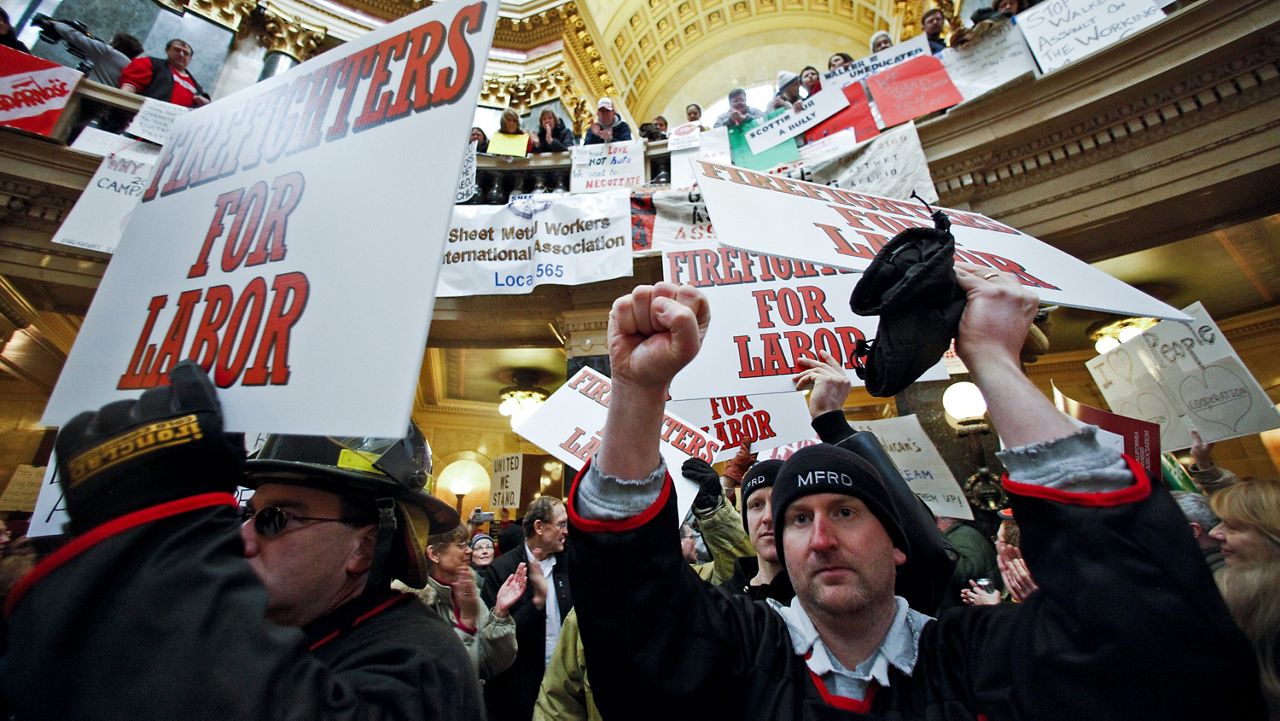MADISON, Wis. — In his 22 years working in corrections in Wisconsin, Chad Birkholz said the current moment stands out.
“Morale in the workplace right now is probably about as low as I’ve ever seen it,” Birkholz said.
At Kettle Moraine Correctional Institution, where Birkholz works, around one-quarter of staff positions are vacant, according to Department of Corrections data. Other facilities have vacancy rates as high as 46%.
Birkholz, a union member, believes a lot of challenges in the workplace have come up since Act 10 went into effect 10 years ago.
Though teachers were a major focus in the protests over the legislation, a whole range of other public workers were also included in its scope — from nurses to sanitation workers to corrections officers, like Birkholz. Firefighters and police officers were excluded from the legislation.
With the changes for public workers in the wake of Act 10, and especially the blows to their collective bargaining power, Birkholz said, “It took away our ability to have meaningful conversation and dialogue with the employer.”
* * *
Long before Act 10 came around, Wisconsin led the country in allowing public workers to unionize in the first place.
In 1959, former Gov. Gaylord Nelson, who would become famous as the founder of Earth Day, signed the first legislation in the U.S. to allow collective bargaining for public workers.
And the American Federation of State, County and Municipal Employees (AFSCME) — a public-sector union that now represents more than 1 million people across the country — got its start bringing together white-collar Madison employees, before growing to include a wide range of professions.
AFSCME members are part of the “frontline of providing services to our community,” said Valerie Landowski, communications director for AFSCME Council 32, the statewide council for Wisconsin.
“For decades, for generations, Wisconsinites were proud to work in public service,” Landowski said. “It was an honor.”
During his campaign and in the leadup to Act 10, Walker made the case that Wisconsin’s public workers were overpaid — at the public’s expense.
“We can no longer live in a society where the public employees are the haves and taxpayers who foot the bills are the have-nots,” he said at a luncheon shortly before taking office, according to Milwaukee Journal-Sentinel coverage at the time.
To help address the state’s budget shortfall, Walker said he wanted to cut down the power of public-sector unions — as well as shift some of the costs of pensions and health care onto the workers themselves, instead of their employers (and, in turn, the taxpayers).
With Act 10, he did just that. The law had an immediate effect on public employees’ pay as employees took on a bigger share of pension and health care costs.
For the average Wisconsin public employee, who was making around $50,000 a year at the time, this meant a decrease of around 8.5%, or $4,228 to their take-home pay, according to Jason Stein and Patrick Marley's book about Act 10.
But beyond the cuts to his paychecks, Birkholz said the bigger change after Act 10 was the loss of collective-bargaining power for public workers.
“Act 10 took away our voice,” he said.
The legislation put limits on the types of things public-sector unions could bargain for with their employers. Post-Act 10, public worker unions can only negotiate over wages — not health care, workplace rules or other benefits — and even then, raises are limited to the rate of inflation.
In Birkholz’s workplace, he said the union and the employers used to have discussions about all kinds of policy changes — like overtime, scheduling and workplace safety. Now, he feels like that type of back-and-forth isn’t happening.
“It's completely dependent on whether they're willing to listen or not,” Birkholz said. “Whereas, with collective bargaining, you know, they had to listen. We sat at a table and we had a meaningful conversation.”
* * *
According to a Wisconsin State Journal analysis, Act 10 did produce billions of dollars of savings in state and local government costs, much of which was put toward tax cuts.
But for the Badger State’s public sector, Landowski said the effects of the legislation have been “devastating” — from “rock-bottom employee morale” to hollowing out of wages and benefits to challenges with employee retention.
These days, Wisconsin’s public sector is smaller than most states’, according to a 2018 analysis by the Wisconsin Budget Project. And it’s been shrinking in recent decades: The analysis found that the Badger State has fewer public workers per capita than in the past.
Though walking away from his job isn’t an option for Birkholz — “I’ve got a family to support” — he said that the changes to the workplace are pushing some workers to retire sooner, and making the job less appealing for new people to apply.
And having a smaller staff makes corrections work even harder, he pointed out, since “a 24/7-run facility still needs to be staffed” no matter how many vacant positions there are.
Act 10 hasn’t put public-sector organizing to a complete end. Landowski said she still sees public workers coming together and advocating in the workplace, despite the loss of collective bargaining power.
We’re now in a “critical time” for the future of Wisconsin workers, Landowski said: The COVID-19 pandemic has highlighted the essential roles of public employees who sometimes go unrecognized. She hopes the support can lead to lasting momentum for public workers.
“It's nice when politicians say that we're heroes, and it's nice when they acknowledge that they couldn’t have made it through this pandemic without us,” Landowski said. “But if you truly stand with the folks who make Wisconsin happen, then that means that you support their freedom to stand with their co-workers.”



